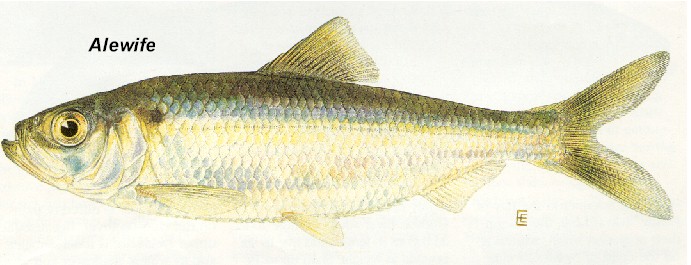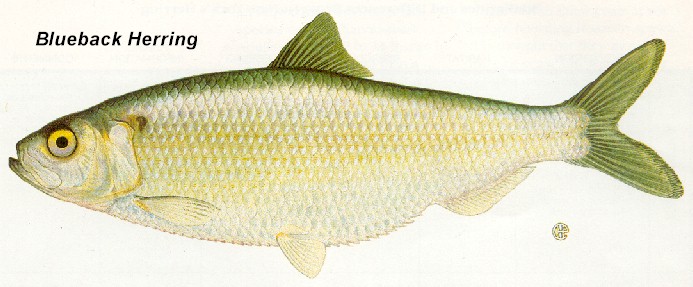Research Overview - Dr.
Randal J. Snyder
Influence
of Dietary Lipids on Cold Tolerance Of Alewives and
Blueback Herring
The alewife (Alosa pseudoharengus) is one of the most important planktivorous fishes in the Great Lakes, providing forage
for  the valuable stocks of
introduced salmonines in Lake Michigan and Lake
Ontario. The Lake Michigan alewife population has been in decline for a
number of years, however, and alewife in Lake Ontario are also showing signs of
stress. Fisheries managers are trying to maintain high stocking rates of
pacific salmon while also attempting to prevent a catastrophic collapse of the
alewife populations. Alewife winter mortality is still one of the key
destabilizing forces in the interactions between salmonines
and alewife in the Great Lakes, and the basic question of why Great Lakes
alewives survive some winters and die in others has never been satisfactorily
explained. While alewives have been present in the Great Lakes since the
1800's, blueback herring (Alosa aestivalis) are just beginning to move
into the Great Lakes watershed from their native range in the Hudson and Mohawk
Rivers. In 1994, more than 9,000 blueback herring were collected in the
Oswego River near Syracuse, New York and in fall 1995 two juveniles were
captured in eastern Lake Ontario. Despite the general similarities between
alewife and blueback herring, they appear to have different temperature, food,
and depth preferences. If established in Lake Ontario, blueback herring
could alter forage base dynamics and potentially influence
the valuable stocks of
introduced salmonines in Lake Michigan and Lake
Ontario. The Lake Michigan alewife population has been in decline for a
number of years, however, and alewife in Lake Ontario are also showing signs of
stress. Fisheries managers are trying to maintain high stocking rates of
pacific salmon while also attempting to prevent a catastrophic collapse of the
alewife populations. Alewife winter mortality is still one of the key
destabilizing forces in the interactions between salmonines
and alewife in the Great Lakes, and the basic question of why Great Lakes
alewives survive some winters and die in others has never been satisfactorily
explained. While alewives have been present in the Great Lakes since the
1800's, blueback herring (Alosa aestivalis) are just beginning to move
into the Great Lakes watershed from their native range in the Hudson and Mohawk
Rivers. In 1994, more than 9,000 blueback herring were collected in the
Oswego River near Syracuse, New York and in fall 1995 two juveniles were
captured in eastern Lake Ontario. Despite the general similarities between
alewife and blueback herring, they appear to have different temperature, food,
and depth preferences. If established in Lake Ontario, blueback herring
could alter forage base dynamics and potentially influence  the ability of the ecosystem
to support the valuable salmonine fisheries. My
research, in collaboration with Dr. Todd Hennessey at SUNY Buffalo, examines
physiological factors associated with winter mortalities of alewife and
blueback herring, specifically the influence of dietary lipids and fatty acids
on their lower lethal temperatures. The basic approach is to manipulate
the diet of these fish in the laboratory, and then to challenge them with cold
temperatures. Lipid analysis, including percent lipid estimation and
fatty acid analysis using gas chromatography, is then carried out to correlate
low temperature tolerance with lipid composition. This information will
be used to develop mechanistic models which will predict the severity of winter
mortalities of these fish, and to assess the likelihood that blueback herring
will successfully survive winters in Lake Ontario and the other Great Lakes.
the ability of the ecosystem
to support the valuable salmonine fisheries. My
research, in collaboration with Dr. Todd Hennessey at SUNY Buffalo, examines
physiological factors associated with winter mortalities of alewife and
blueback herring, specifically the influence of dietary lipids and fatty acids
on their lower lethal temperatures. The basic approach is to manipulate
the diet of these fish in the laboratory, and then to challenge them with cold
temperatures. Lipid analysis, including percent lipid estimation and
fatty acid analysis using gas chromatography, is then carried out to correlate
low temperature tolerance with lipid composition. This information will
be used to develop mechanistic models which will predict the severity of winter
mortalities of these fish, and to assess the likelihood that blueback herring
will successfully survive winters in Lake Ontario and the other Great Lakes.
More recent projects have examined the influence of dietary fatty acids on
growth and overall health of alewives.